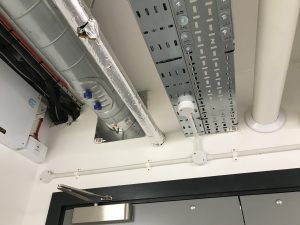Fire Stopping Surveys – Taking Action
What is Fire Stopping?
Fire stopping is the sealing of gaps, breaches or issues found around fire resistant floors, doors and construction. It is a range of compliant products that are installed to help slow the spread of fire through a building. The materials used in a fire stop must be able to resist fire for a reasonable period of time. Sometimes, fire stopping is not applied correctly or even at all by contractors, at times when construction or refurbishment or minor works occur within a property. If there is no fire stopping around the engineered fire resistant areas, if it has been incorrectly installed or if cracks and openings are appearing around existing fire stopping, this ultimately puts lives at risk.
Do I need a Fire Stopping Survey?

In order to determine whether there are any issues, a Fire Stopping Survey needs to be conducted. A Fire Stopping Survey, which should not be confused with a Compartmentation Survey, assesses where fire resisting walls have been breached and highlight where remedial works need to be performed to restrict the spread of fire and smoke throughout a building.
The survey will identify the problem areas. A surveyor will thoroughly inspect above suspended ceilings, loft spaces and between floors. The purpose of this is to ensure that fire cannot extend through the building by travelling through the voids.
Doesn’t my Fire Risk Assessment cover this?
If you’ve had a Fire Risk Assessment, you may believe that this is enough. However, a risk assessment is a very different thing to a Fire Stopping Survey. A Fire Risk Assessment will cover a broad range of areas and will simply identify that there are fire stopping issues. You will then need a Fire Stopping Survey to properly evaluate these issues and understand the appropriate action that needs to take place to remedy them.
What are my legal obligations?
As with a risk assessment, there is no law in place that says you have to take any actions. The survey will only make recommendations on what needs to be done. However, responsible people do have a duty of care. Therefore, if the worst happened and a fire spread through your building due to inadequate fire stopping, questions may then start to be asked. Having said this, if you knew there were problems and you did nothing about it, you are knowingly ignoring risks and making the people in your building vulnerable.
Fire Stopping Surveys – Take Action
At RM, our advice is always to take action. If your survey makes recommendations to carry out work to help secure a building, the safest thing to do is to follow the recommendations. It’s not worth the risk to lives leaving a problem unresolved. It really can come down to a matter of life and death in these situations.
If you are looking to resolve issues highlighted in your survey, the next thing to do is make sure you are using a competent person. Doing the work incorrectly is often as bad as not doing it at all.
Competency
When it comes to sealing a fire stopping breach that will help to prevent fires, not just any material can be applied. In order to ensure that a property is safe, the right tools, products and processes must be used. That’s why it is always advisable to use a third party certified contractor for this kind of work. Using someone certified means they know what products to use and they will complete the job effectively.
There are numerous contractors that could complete the work. However, if you don’t question whether they are certified, then their work may not be worth anything at all. Doing it incorrectly can cost lives. It sounds shocking but it’s true.
If you’d like to book a Fire Stopping Survey or require details of a third party contractor with the right skills to complete your fire stopping work, please contact us at RM Risk Management. We can recommend trustworthy, certified suppliers to help you complete the work.
Don’t leave your building or your people at risk. If you’re not sure what to do, please contact us and we can help.